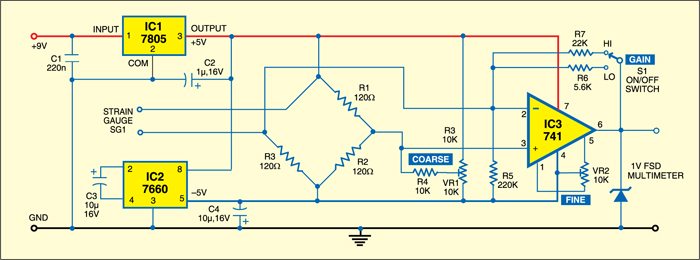 This strain meter shows whether the strain is compressive (reducing the length) or tensile (increasing the length) when an object such as a strut on a crane changes its shape. The strain is sensed by a strain gauge that is glued to the object being tested. The change in resistance of the strain gauge produces a change in the reading of the meter. For the purpose, an analogue or digital meter, such as a voltmeter, can be used that has a full-scale deflection of 1V DC. But the use of a digital multimeter would be better.
This strain meter shows whether the strain is compressive (reducing the length) or tensile (increasing the length) when an object such as a strut on a crane changes its shape. The strain is sensed by a strain gauge that is glued to the object being tested. The change in resistance of the strain gauge produces a change in the reading of the meter. For the purpose, an analogue or digital meter, such as a voltmeter, can be used that has a full-scale deflection of 1V DC. But the use of a digital multimeter would be better.
Strain meter circuit

The circuit shows how a single op-amp IC 741 (IC3) amplifies the output from a network of three resistors (R1 through R3) and strain gauge SG1. Since the nominal resistance of the strain gauge recommended for this circuit is 120 ohms, each of resistors R1 through R3 should have a value of 120 ohms. The resistors should also have a tolerance of better than 0.1 percent so that any change in the temperature doesn’t cause unwanted changes in the reading of the meter.
Circuit operation
Working of the circuit is simple. When the strain gauge is unstrained, variable resistors VR1 (coarse control) and VR2 (fine control) are set to give a zero reading on the multimeter. (This zero voltage may instead be any convenient voltage, such as 1.5V, and not necessarily a zero voltage supply for the circuit.) If the meter reading increases, it indicates that the strain gauge is undergoing an increase in length (tensile strain). If the meter reading decreases, the strain gauge is undergoing a decrease in length (compressive strain).
Using variable resistor VR2, you can adjust the sensitivity of the op-amp (IC3). It enables the circuit to respond to different magnitudes of the strain. 5V and -5V supply voltages provided by voltage regulators IC1 and IC2, respectively, assure stable readings on the meter. The op-amp amplifies the output from the Wheatstone bridge.
Construction & assembly
Assemble the circuit on a general-purpose PCB. Use appropriate PCB sockets to terminate the wire ends for connecting the strain meter to the multimeter, battery and strain gauge.
Use Araldite to glue the strain gauge to the surface of a 150×10×1mm3 strip of a plastic pad. Plug the strain gauge into the strain meter. Use a digital multimeter to measure negative voltages since this makes setting up easier.
The strain meter needs to be set up such that when the strain gauge is unstrained, the output voltage is about 0.5V. If the plastic strip is bent such that the strain gauge becomes slightly longer (tensile stress), the output voltage should increase. But if it is bent such that the strain gauge becomes slightly shorter (compressive stress), the output reading should decrease.
The setting is done by adjusting multiturn trimmers VR1 and VR2 using an adjusting tool made for the job. Proceed as follows:
- Set the multimeter to 0V to 5V DC range.
- Keep S1 in ‘LO’ position.
- Adjust VR1 and VR2 until the reading on the voltmeter is about +0.5V.
- Check whether the reading on the voltmeter changes when you bend the plastic strip.
- Switch the multimeter to its 1V range, bend the strip again and then mark the response.
If the response is not sensitive enough, flip switch S1 to ‘HI’ position. Readjust VR1 to make sure that the reading is still within the range. You may increase the gain by increasing the values of resistors R6 and R7.
The project was first published in September 2010 and has recently been updated.









Hello, friends,
What are the characteristics of the zener diode?.
Thanks,